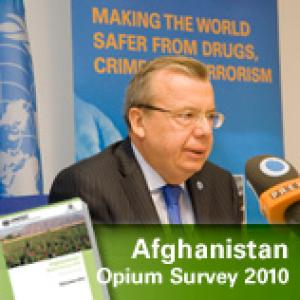Consequences of Prohibition
Drug War Issues
Politics & Advocacy

opium poppies (incised papaver specimens)
"This is good news but there is no room for false optimism; the market may again become lucrative for poppy-crop growers so we have to monitor the situation closely," said Yuri Fedotov, new executive director of UNODC.
Afghanistan produces more than 90% of the world's opium, the raw ingredient used to make heroin. Production of the illicit crop is centered in southern Helmand and Kandahar provinces, home base of the Taliban insurgents. Profits from the opium trade fund the Taliban to the tune of an estimated hundred millions of dollars each year.
UNODC said slightly more than 300,000 acres were planted with poppy this year, about the same as last year after declines the two previous years. But because of the plant disease, opium production was estimated at 3,600 metric tons, down 48% from 2009.

The stability in poppy cultivation comes despite years of efforts and billions of dollars invested in suppressing the trade. The US spent $250 million on anti-drug efforts in Afghanistan this year alone, according to the State Department's Office of International Narcotics and Law Enforcement (or "drugs and thugs," as Foggy Bottom wits like to call it).
Fedetov, a veteran Russian diplomat who took over the reins of UNODC earlier this year and whose home country is confronting high levels of heroin addiction, said a broader strategy was needed to end Afghan poppy planting. "As long as demand drives this market, there will always be another farmer to replace one we convince to stop cultivating, and another trafficker to replace one we catch," he said.
This work by StoptheDrugWar.org is licensed under Creative Commons Attribution-ShareAlike 4.0 International
Comments
withholding information?
I love it how they only mention opium is used to make diamorphine (heroin). Since it is easy to see the true nature, in the scientific name, the drug should have never been classified, as a class one drug. It should be like morphine and codeine, at least! They are controlled class two and three drugs. The legal production of opium is used to make medicine! But we can't make more pain medicine for people! It turns them into addicts! (according to the misinformed!?)
Heroin is no different than the other opiates, synthetic or not. Its only problem is the fact that we have changed the name of the drug and ignored what it really is! (Fentanyl is much stronger)! And "hillbilly heroin" is a way for our, illustrious, drug officials use to denigrate a medicine, Oxycodone, that can be useful to patients that have legitimate pain. The problem begins with the people that don't know the difference between chronic pain management with dependence, as compared to addiction. There is a difference, but no one writing these articles knows it. And , they don't care abut the fact that untreated chronic pain is one of the biggest problems in medicine, today.
Another problem associated with it is the people who access the pills, just to resell them! But, if there were no black market, they would not get $5.00/pill for the, various, opiates. With that type of profit, they can get by without having any other type of income! The government wonders why it happens? It is partially, the lack of employment for some, who take the risk of being caught for drug dealing, to be able to survive!
Sincerely,
has been pain doctor
our as in the U.S. military
our as in the U.S. military is helping them grow the shit. But if you get busted over here in OUR free union of states you get to go vacation with the state in the federal Pokey. Ya know if I am a lazy burden on whoever supposedly freedom of choice lol. why don't we call this place Great Briton were just as TAX HAPPY little bit IRONIC don't you think?
Add new comment